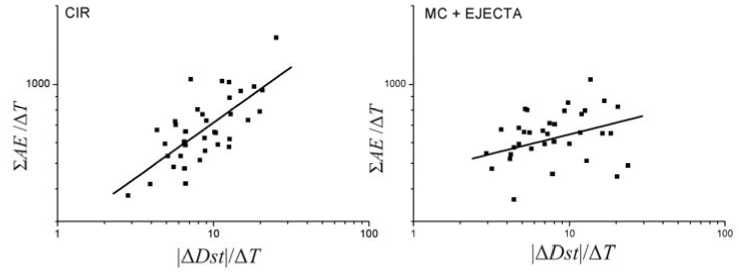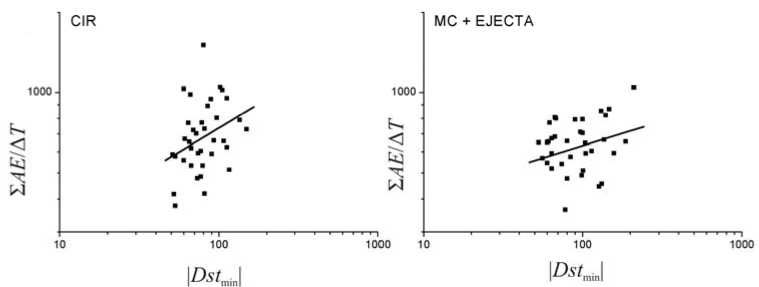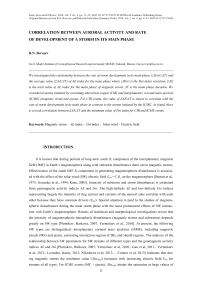Корреляция скорости развития магнитной бури на главной фазе и авроральной активности
Автор: Бороев Р.Н.
Журнал: Солнечно-земная физика @solnechno-zemnaya-fizika
Статья в выпуске: 4 т.2, 2016 года.
Бесплатный доступ
Исследовалась связь между скоростью развития магнитной бури на главной фазе |Δ Dst |/Δ T и средней величиной AE -индекса (Σ АЕ /Δ T ) за время главной фазы, где |Δ Dst | - изменение Dst -индекса, Σ АЕ - суммарное значение АЕ -индекса за время главной фазы магнитной бури, Δ T - длительность главной фазы. Рассмотрены бури, инициированные областью сжатия перед высокоскоростными потоками (corotating interaction region, CIR) и межпланетными проявлениями корональных выбросов IСМE (магнитные облака и ejecta). Анализ показал, что величина Σ АЕ /Δ T коррелирует со скоростью развития магнитной бури для CIR-событий в отличие от бурь, инициированных ICME-событиями. Обнаружена слабая корреляция между Σ АЕ /Δ T и минимальным значением Dst -индекса магнитной бури для CIR- и ICME-событий.
Магнитная буря, ae-индекс, dst-индекс, солнечный ветер, электрическое поле
Короткий адрес: https://sciup.org/142103624
IDR: 142103624 | УДК: 523.62 | DOI: 10.12737/21404
Текст научной статьи Корреляция скорости развития магнитной бури на главной фазе и авроральной активности
It is known that during periods of long-term south B z component of the interplanetary magnetic field (IMF) in Earth’s magnetosphere along with substorm disturbances there occur magnetic storms. Effectiveness of the south IMF B z component in generating magnetospheric disturbances is associated with the effect of the solar wind (SW) electric field E sw = V x B z on the magnetosphere [Burton et al., 1975; Gonzalez et al., 1994; Kane, 2005]. Intensity of substorm and storm disturbances is estimated from geomagnetic activity indices АЕ and Dst . The high-latitude АЕ and low-latitude Dst indices representing largely the intensity of ring current and currents of the auroral zone correlate with each other because they have common drivers ( E sw ). Special attention is paid to the studies of magnetospheric disturbances during the main storm phase with the most pronounced effects of SW interaction with Earth’s magnetosphere. Results of statistical and morphological investigations reveal that the intensity of magnetospheric-ionospheric disturbances (magnetic storms and substorms) depends greatly on SW type [Plotnikov, Barkova, 2007; Yermolaev et al., 2010]. At present, the following SW types are distinguished: interplanetary coronal mass ejections (ISME), including magnetic clouds (MS) and ejecta, corotating interaction regions (CIR), and sheath regions. The analysis of the relationship between SW parameters for SW streams of different types and the geomagnetic activity indices AE and Dst [Plotnikov, Barkova, 2007; Yermolaev et al, 2010.; Guo et al, 2011.; Yermolaev et al, 2012.; Liemohn, Katus, 2012; Nikolaeva et al, 2013.; . Cramer et al, 2013] indicates that during magnetic storms the minimum value (| Dst min |) increases with increasing electric field E sw for streams of all types. For ICME events (MC + ejecta), | Dst min | attains the saturation at large values of 11
E sw [Nikolaeva et al., 2015]. Unlike D st , AE during the main storm phase is independent of E sw for streams of almost all types, except MS. There is a nonlinear dependence of AE on E sw in MS events.
It should be noted that the Dst variation defines intensity not only of the ring current, but also of the current on the magnetopause, the current system of the magnetotail, and high-latitude magnetospheric-ionospheric currents [Feldstein et al., 2005]. Using the high-latitude AE index, we can take into account the contribution of magnetospheric-ionospheric current systems to the Dst variation.
However, due to different time scales of substorm and storm disturbances, AE gives only a rough idea of the role the magnetospheric-ionospheric current systems play in the development of a magnetic storm. In addition, during magnetic storms not only the intensity of auroral currents, but also their shift to lower latitudes determines the value of AE .
The purpose of this work is to examine the relationship between the dynamics of Dst and AE variations during the main storm phase for different SW types.
EXPERIMENTAL DATA
For the analysis, magnetic storms have been selected from the catalog of large-scale phenomena of the solar wind for 1976–2000 [Yermolaev et al., 2009]. More detailed information is given on the website [ftp://]. For the 1976–2000 period, 72 magnetic storms initiated by CIR and ICME (MC + ejecta) events have been chosen. Magnetic storms caused by a sheath region are not considered in this paper. Hourly AE and Dst values have been taken from the website [ / the ]. The minimum negative |Dst| during the magnetic storms was more than 50 nT. Moderate and strong magnetic storms after a magnetically quiet period were analyzed. For each of the event, the rate of magnetic storm development during the main storm phase |Δ Dst|/ΔT was calculated. Duration of the main storm phase ΔT was defined as the time interval Dst0 from the instant of a sharp decrease in Dst to its minimum value Dstmin, and |ΔDst| = |Dstmin - Dst0|. To account for the displacement of the auroral oval during a magnetic storm and substorm as well as the duration of substorm disturbances (1–3 hr), the average value of AE for the main phase Σ AE/ΔT was computed, where Σ AE is the total value of AE during the main phase.
RESULTS AND DISCUSSION
Figure 1 shows the relationship between the average value of AE (Σ AE /Δ T ) and the rate of magnetic storm development for the storms initiated by CIR (left) and ICME (right) events. Squares mark individual magnetic storms; straight lines are linear approximations. The table lists equations of linear regressions between Σ AE /Δ T and the rate of magnetic storm development for two SW types. For comparison, the table gives correlation coefficients and probabilities of relationship of Σ AE /Δ T with the rate of magnetic storm development as well as with | Dst min |/Δ T and | Dst min |.

Figure 1. Relationship between Σ AE /Δ T and the rate of magnetic storm development |Δ Dst |/Δ T for storms initiated by CIR and ICME (MC + ejecta) events
It can be seen that Σ AE /Δ T monotonically increases for different SW types with increasing rate of magnetic storm development. However, the analysis shows (Table) that the relationship between Σ AE /Δ T and |Δ Dst | /Δ T is more strongly pronounced and statistically significant for the storms initiated by CIR events ( r = 0.71; P = 99%) than for those driven by ICME ( r = 0.33; P = 97%). Thus, the average AE index is clearly correlated with the rate of magnetic storm development for CIR-events, whereas for ICME events this correlation is weak. If instead of the rate of magnetic storm development |Δ Dst |/Δ T we consider a new parameter | Dst min |/Δ T , which includes | Dst min | and Δ T , then there is a slight increase in the correlation coefficient between Σ AE /Δ T and | Dst min |/Δ T in contrast to the correlation coefficient between Σ AE /Δ T and |Δ Dst |/Δ T (Table).
The number of storms, correlation coefficients r, probabilities P, and approximations for the relationship of Σ AE/ΔT with the rate of storm development, with the parameters |Dstmin|/ΔT, and |Dstmin| for CIR and ICME initiated storms
|
SW type |
N |
|Δ Dst |/Δ T |
|Dst min |/Δ T |
|Dst min| |
||||
|
r |
P |
approximation |
r |
P |
r |
P |
||
|
CIR |
36 |
0.71 |
0.99 |
ln y =0.42ln x +2.43 |
0.76 |
0.99 |
0.32 |
0.95 |
|
ICME |
36 |
0.33 |
0.97 |
ln y =0.14ln x +2.66 |
0.35 |
0.97 |
0.26 |
0.88 |
To evaluate the possible relationship between Σ AE /Δ T and Dst , a relationship was built between Σ AE /Δ T and | Dst min | (Figure 2). The analysis shows extremely weak correlation between them ( r <0.5) for different SW types (Table).

Figure 2. Relationship between Σ AE /Δ T and | Dst min| for storms initiated by CIR and ICME (MC + ejecta) events
It is known that the time variation of Dst ( d | Dst |/ dt ) during the main storm phase is conditioned by the SW electric field [Kane, 2010; Yermolaev et al, 2010.; Nikolaeva et al, 2014.; Yermolaev et al., 2016]. If we suppose that the Dst variations are related to |Δ Dst |/Δ T , then |Δ Dst |/Δ T is determined by the mean value of E sw [Yermolaev et al, 2016]. Thus, the results obtained indicate that for CIR events Σ AE /Δ T may correlate with the average value of E sw during the main storm phase.
CONCLUSION
In this paper, the relationship has been studied between Σ AE /Δ T and the rate of magnetic storm development for magnetic storms initiated by ICME (36) and CIR (36) events. The following results have been obtained.
-
1. During CIR events, Σ AE /Δ T correlates with the rate of magnetic storm development as opposed to ICME events.
-
2. The value of Σ AE /Δ T correlates weakly with | Dst min | for CIR- and ICME-generated magnetic storms.
This work was supported by RFBR grant No. 15-45-05090.
Список литературы Корреляция скорости развития магнитной бури на главной фазе и авроральной активности
- Ермолаев Ю.И., Николаева Н.С., Лодкина И.Г., Ермолаев М.Ю. Каталог крупномасштабных явлений солнечного ветра для периода 1976-2000 гг.//Косм. иссл. 2009. Т. 47, № 2. С. 99-113.
- Ермолаев Ю.И., Лодкина И.Г., Николаева Н.С., Ермолаев М.Ю. Зависит ли длительность фазы вос-становления магнитной бури от скорости развития бури на ее главной фазе? 2. Новый метод//Геомагнетизм и аэрономия. 2016. Т. 56, № 3. С. 296-301.
- Николаева Н.С., Ермолаев Ю.И., Лодкина И.Г. Моделирование временного хода Dst-индекса на главной фазе магнитных бурь, генерированных разными типами солнечного ветра//Косм. иссл. 2013. Т. 51, № 6. С. 443-454.
- Николаева Н.С., Ермолаев Ю.И., Лодкина И.Г. Зависимость геомагнитной активности во время маг-нитных бурь от параметров солнечного ветра для разных типов течений. 4. Моделирование для магнитных облаков//Геомагнетизм и аэрономия. 2014. Т. 54, № 2. С. 163-173.
- Burton R.K., McPherron R.L., Russell C.T., An empirical relationship between interplanetary conditions and Dst//J. Geophys. Res. 1975. V. 80. P. 4204-4214.
- Cramer W.D., Turner N.E., Fok M.C., Buzulukova N.Y. Effects of different geomagnetic storm drivers on the ring current: CRCM results//J. Geophys. Res. 2013. V. 118 DOI: 10.1002/jgra.50138
- Feldstein Y.I., Levitin A.E., Kozyra J.U., et al. Self-consistent modeling of the large-scale distortions in the geomagnetic field during the 24-27 September 1998 major magnetic storm//J. Geophys. Res. 2005. V. 110. DOI: 10.1029/2004JA010584.
- Guo J., Feng X., Emery B.A., et al. Energy transfer during intense geomagnetic storms driven by interplanetary coronal mass ejections and their sheath regions//J. Geophys. Res. 2011. V. 116 DOI: 10.1029/2011JA016490
- Gonzalez W.D., Joselyn J.A., Kamide Y., et al. What is a geomagnetic storm?//J. Geophys. Res. 1994. V. 99. P. 5771-5792.
- Plotnikov I.Ya., Barkova E.S. Advances in space research nonlinear dependence of Dst and AE indices on the electric field of magnetic clouds//Adv. Space Res. 2007. V. 40. P. 1858-1862.
- Kane R.P. How good is the relationship of solar and interplanetary plasma parameters with geomagnetic storms?//J. Geophys. Res. 2005. V. 110 DOI: 10.1029/2004JA010799
- Kane R.P. Scatter in the plots of Dst(min) versus Bz(min)//Planetary and Space Science. 2010. V. 58. P. 792-1801.
- Liemohn M.W., Katus R. Is the storm time response of the inner magnetospheric hot ions universally similar or driver dependent?//J. Geophys. Res. 2012. V. 117. DOI: 10.1029/2011 JA017389.
- Nikolaeva N.S., Yermolaev Yu.I., Lodkina I.G. Predicted dependence of the cross polar cap potential saturation on the type of solar wind stream//Adv. Space Res. 2015. V. 56. P. 1366-1373.
- Yermolaev Yu.I., Nikolaeva N.S., Lodkina I.G., Yermolaev M.Yu. Specific interplanetary conditions for CIR-, sheath-, and ICME-induced geomagnetic storms obtained by double superposed epoch analysis//Ann. Geophysicae. 2010. V. 28. P. 2177-2186.
- Yermolaev Y.I., Nikolaeva N.S., Lodkina I.G., Yermolaev M.Y. Geoeffectiveness and efficiency of CIR, sheath, and ICME in generation of magnetic storms//J. Geophys. Res. 2012. V. 117. A00L07 DOI: 10.1029/2011JA017139
- URL: ftp://ftp.iki.rssi.ru/omni/(дата обращения 12 мая 2016 г.).
- URL: http://wdc.kugi.kyoto.u.ac.jp/index.html (дата обращения 12 мая 2016 г.).


